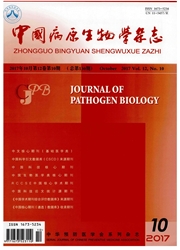

 中文摘要:
中文摘要:
目的 HpaA是幽门螺杆菌(Helicobacter pylori)的主要粘附因子,参与幽门螺杆菌在人胃黏膜上的定植过程。特异性阻断HpaA与人胃上皮细胞的粘附,可能成为阻断Hp感染的新方法,从而弥补常规治疗中出现的毒副作用大、耐药性等问题。方法以人工合成的HpaA主要结构域KRTIQKKRTIQK多肽为靶标,应用噬菌体随机十二肽库进行筛选,经过3轮淘选,提取阳性噬菌体克隆ssDNA,测序并进行序列分析。通过相应的分析软件对亲和肽进行分析比对。结果通过多次筛选与富集,获得了与HpaA相互作用的功能分子ASPH、EGR2。运用软件模拟发现ASPH、EGR2均能与HpaA分子高度吻合。结论通过噬菌体肽库技术筛选出与幽门螺杆菌主要粘附分子HpaA相互作用的2个功能分子,可能参与幽门螺杆菌的定植与致病过程,为进一步研究幽门螺杆菌在人胃内致病的机制和多肽治疗方法提供了依据。
 英文摘要:
英文摘要:
Objective Helicohacter pylori adhesin A (HpaA) is the main adhesion factor of H. pylori and is involved in the bacterial colonization of human gastric mucosa. Specifically inhibiting the adhesion of H. pylori to human epithelial cells may be a possible way to inhibit H. pylori infection. This treatment could also deal with other issues such as ad- verse reactions to conventional treatment and drug resistance. Methods Short synthetic peptides of HpaA's major do- main KRTIQK were used as a target to screen for compatible short peptides from a phage display library. Positive phage clones were obtained by 3 rounds of biopanning, followed by single-stranded DNA extraction and sequencing. Results Repeated screening and enrichment yielded the functional molecules ASPH and EGR2, both of which interact with HpaA. A software simulation indicated that ASPH and EGR2 closely bind to HpaA molecules. Conclusion Two functional candidates that interact with HpaA were identified from a phage display library. This lays the theoretic foundation for fur ther study of the mechanisms of HpaA colonization and the pathogenicity of H. pylori
 同期刊论文项目
同期刊论文项目
 同项目期刊论文
同项目期刊论文
 期刊信息
期刊信息
